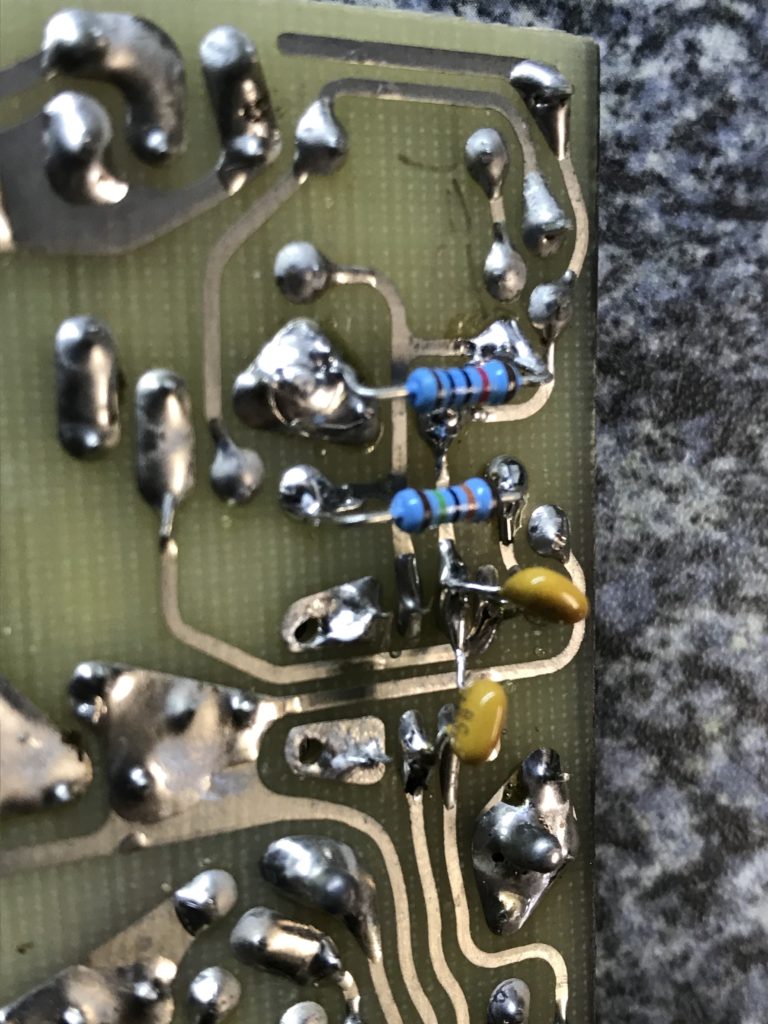The straightforward solution is to use a Quad 303, taking care to use “version 2” for audio transformer of ESL 57 (see dedicated page otherwise for an upgrade). Of course, there are other (safe) solutions (Quad II, Quad 405, Naim Nait 1, …), already detailed in many other sites. For example:
http://quadesl.org/index.php/hard-core/amplifiers/christian-steingruber
Note that ESL 57 may not handle correctly heavy low bass frequencies at high volume. Especially if refurbished: aged cells lose capability to reproduce low frequencies as low as 50Hz.
In all cases select an amplifier that stays below 20Vrms as a Quad 303 does (or a Quad 405 with limitation option installed).
Quad 303
My intention is to drive a Quad 303 directly with a Quad 99 CDP. First of all, schematic of Quad 303:

This means 220kOhm for input impedance. As confirmed in this document:
Output of 99 CDP is 2.4V RMS, compared to claimed 0.5V RMS sensitivity for Quad 303. Thus, attenuation of about 13.5dB is nice to have.
Either insert some attenuator (look for “rothwell attenuators”, version “for source”, 15dB), or a DIY solution (1MOhm resistor in series ?), or use volume 21 or below on CDP. This leaves up to 74dB of attenuation by steps of 2 (till vol 17) then 3 (till vol 9) then 4 (till vol 8) then 5 dB. All details here:
https://www.stereophile.com/content/quad-99-cdp-2-cd-player-measurements#iuR6ikIkc06uGu5T.99

If inserting a 15dB attenuator, full range of volume on CDP becomes usable.
On top of this, you will need a “Quad 4 Pin Din Plug to 2 x RCA Phono Plugs”, unless modifying Quad 303.
Last option, but best one in fact: change few components in 303 to reduce gain. DadaElectronics says: “for 1V sensitivity, solder a 22k in parallel with R108 and a 100pF C in parallel to C103 on the copper side”. See here.
Quad 405
For a Quad 405, you must see to it to add resistor R11 (1.8kOhm, 1/2W). All details here (from Keith Snook):
Service data, if needed. For example, to replace electrolytic capacitors C5 and C10 after few tenths of years :
WARNING: take care page 15: this is not ISS9 as indicated, but ISS8 ! Check Zener diodes if you have doubt: 12V for ISS8, 15V for ISS9. ISS9 is for SN 29000 to 59000.


For one channel, both C5 & C10 were obviously defective (see picture: 81nF iso 100uF). For the other channel, they were far from target.
Consequence for defective capacitors: some noise on output, 100Hz.

My selection for C5 & C10 (and by the way C2), one per channel:
- Würth Elektronik WCAP-ATUL 860040775006: 100 µF 63 V 105°C
- Würth Elektronik WCAP-ATUL 860040875002: 47 µF 100 V 105°C
- Kemet Tantale 100 µF 10V T350J107K010AT
Since changing components, let’s reduce gain by a factor 3, and upgrade OpAmp. This is common modification widely described elsewhere:
https://www.desmith.net/NMdS/Shack/Bernd%20Ludwig%20405%20Modifications%20V13.pdf



Hum at 100Hz has disappeared. New gain measured at +25dB, iso historical +35dB. With 99-CDP, I still need to limit to setting 28 for volume (1.5V vs 2.4V: -4dB). Or even 25 if voltage limiting option is installed (R11).
![]()